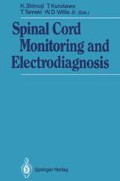Abstract
The monitoring of the motor system is an important goal for spinal cord evaluation. Ideally we need a safe procedure, easily used, reliable, and able to indicate problems with the upper or lower motor neuron pathways. Until a few years ago little was available in such a direction. However, the advent of both spinal cord stimulation and transcranial motor pathway stimulation has offered the opportunity to develop such testing. A particularly useful type of transcranial stimulation in the awake patient is the magnetic stimulator, first described in 1985 by Dr. Anthony Barker. This stimulator was initially limited by the large surface area of brain which it stimulated, and by the fact that it was just powerful enough to stimulate awake patients. Therefore it was often not reliable on an anesthetized patient with a higher stimulus threshold. The technology of these devices is evolving rapidly, and more powerful stimulators are being tested by Novametrix and Cadwell Labs, as well as some other groups. The one which has been initially evaluated for the operating room is the Cadwell MES-10. This can stimulate patients in the operating room under some conditions.
Access this chapter
Tax calculation will be finalised at checkout
Purchases are for personal use only
Preview
Unable to display preview. Download preview PDF.
References
Agnew, McCreery (1987) Safety in transcranial stimulation. Neurosurgery 20 (1): 100–109
Barker AT, Jalinous R, Freeston IL (1985) Non-invasive magnetic stimulation of human motor cortex. Lancet i: 1106–1007
Bridge SL, Delaney RC (1989) Transcranial magnetic stimulation: An Assessment of Cognitive and other cerebral effects. Neurology 39: 417–419, 1989
Brown Rh, Nash CL, Lorig RA, Schatzinger LA (1977) Spinal cord monitoring during operative treatment of the spine. Clin Orthop 126: 100–105
Edmunds HL, Paloheimo MPJ, Backman M, Johnson JR, Holt RT, Schields CB (1989) Transcranial magnetic motor evoked potentials (tcMMEP) for functional monitoring of motor pathways during scholiosis surgery. Spine 14: 683–686
Levy WJ (1987) SEP vs MEP debate: the monitoring of motor pathways. Clin Neurosurg 34: 239–260
Levy WJ, McCaffrey M, York DH, Tanzer F (1984) Motor evoked potentials from transcranial stimulation of the motor cortex in humans. Neurosurgery 15: 214–227
Levy WJ, McCaffrey M, York DH, Tanzer F (1984) Motor evoked potentials from transcranial stimulation of the motor cortex in cats. Neurosurgery 15: 287–302
Levy WJ, Oro J, Tucker D (1989) Safety studies of electrical and magnetic stimulation for the production of motor evoked potentials. In: Magnetic stimulation in clinical neurophysiology. Butterworth, London
Moller AR (1987) Electrophysiological monitoring of cranial nerves in operations in the skull base. In: Sekar LN, Schramm V (eds) Tumors of the cranial base: diagnosis and treatment. Futura, Mt. Kisco
Moller AR, Jannetta PJ (1984) Preservation of facial nerve function during removal of acoustic neuromas. Use of monopolar constantp-voltage stimulation adn EMG. J Neurosurg 61: 757–760
Moller AR, Jannetta PJ (1985) Monitoring of facial nerve function during removal of acoustic tumor. Am J Otol [November Suppl]: 27–29
Prass R, Luders H (1986) Acoustic (loudspeaker) facial electromyographic monitoring Part 1. Neurosurgery 19: 392–400
Raudzens PA (1982) Intraoperative monitoring of evoked potentials. In: BodisWollner I (ed) Evoked potentials. New York Academy of Sciences, New York, pp 308–325
Author information
Authors and Affiliations
Editor information
Editors and Affiliations
Rights and permissions
Copyright information
© 1991 Springer-Verlag Berlin Heidelberg
About this paper
Cite this paper
Levy, W.J., Oro, J., Traad, M. (1991). Motor Evoked Potentials: Issues in Safety and Operative Monitoring. In: Shimoji, K., Kurokawa, T., Tamaki, T., Willis, W.D. (eds) Spinal Cord Monitoring and Electrodiagnosis. Springer, Berlin, Heidelberg. https://doi.org/10.1007/978-3-642-75744-0_35
Download citation
DOI: https://doi.org/10.1007/978-3-642-75744-0_35
Publisher Name: Springer, Berlin, Heidelberg
Print ISBN: 978-3-642-75746-4
Online ISBN: 978-3-642-75744-0
eBook Packages: Springer Book Archive

